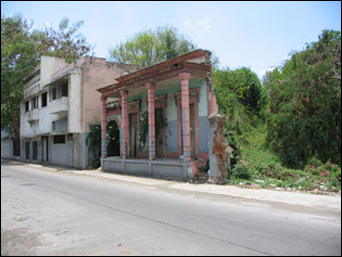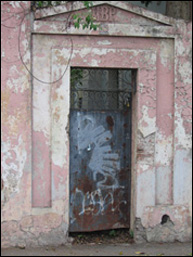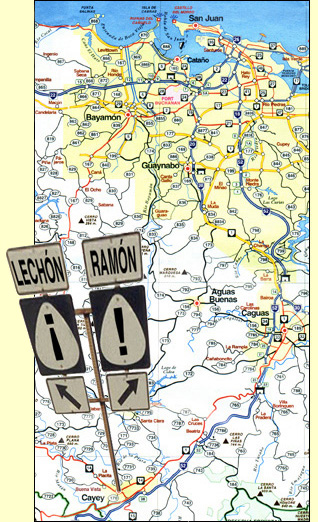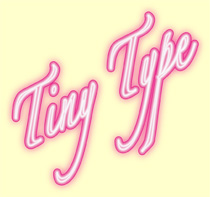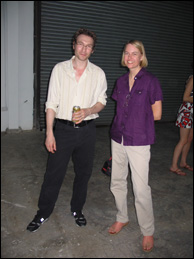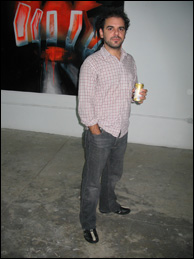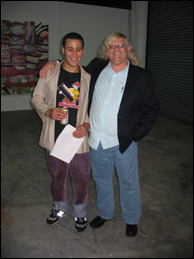
Rotund Gets Mail
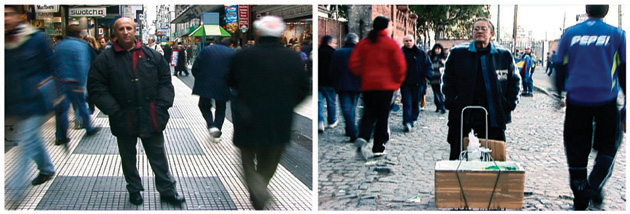 ¿Juvenil o derivada? Not a pertinent question, says Marysol Nieves. And she should know.
¿Juvenil o derivada? Not a pertinent question, says Marysol Nieves. And she should know.
Stills from a two-channel projection of digital video, by caraballo-farman.
Left, “Señor Cambio (Sir Change Money),” 2003, and, right, “Gaseosa Fría,” 2003.
Images courtesy of the Museo de Arte de Puerto Rico.
I love a good asinine letter-to-the-editor. The thought of getting one or two was right up there in the top ten reasons for starting Rotund World. Alas, Marysol Nieves, the just-departed curator of contemporary art at the Mueso de Arte de Puerto Rico (MAPR), took enormously tactful, though firm, exception to my review of her last show at the museum, “The (S) Files,” a collaboration between MAPR and New York City’s El Museo del Barrio. (She told me she’ll be returning to San Juan from time to time to fulfill commitments for a number of project room shows at MAPR.)
Personally, I don’t think Marysol and I disagree much about the substance of what I wrote here. But read on. You might decide otherwise. As a bonus, you’ll probably get a much clearer understanding of what the hell the exhibition was all about since we at Rotund World, so given to sarcasm, potty humor, and an obnoxious degree of self-referentiality, rarely concern ourselves with journalistic niceties, which we consider outmoded nuisances.
Marysol writes: I read your review of “The (S) Files,” and although I don’t disagree necessarily with your assessment, I do think that it is a bit unfair to describe an exhibition of this nature as “juvenil” and “derivada.” By its very nature, “The (S) Files Biennial” series is intended to be fairly inclusive, rather than a tight curatorial selection. While this is not a curatorial model that reflects my usual modus operandi, I do believe wholeheartedly that there is a place for this type of exhibition—that is, an exhibition that casts a wide net, is intentionally unwieldy and uneven, with the occasional pleasant and not so pleasant surprises. In other words I think its the nature of the beast. Isn’t this why we all love to hate the Whitney Biennial?
Let us not forget that this is also a biennial of largely emerging artists, many of whom are just out of BFA or MFA programs (such as our friend Quintín). The derivative nature of their work denotes the fact that many of these artists are still heavily influenced by their art school experience and still developing their own language and honing their practice.
I think it’s also important to place this biennial in its proper context. This biennial is a product of the mission and vision of El Museo del Barrio, that by its very definition is an institution rooted in notions of inclusivity—culturally and aesthetically.
Finally, there is the PR context which is probably why your review concerned me the most. While many of the works in the exhibition may seem derivative to a more sophisticated art audience, the public’s understanding and appreciation of contemporary art in PR is still quite limited. I think it’s extremely important for conservative and insular institutions like MAPR to embrace exhibitions like these because for better or for worse by appearing at this venue it validates contemporary art for an audience that is often confounded and frustrated by this type of work. MAPR’s own interest or commitment to contemporary art is lukewarm; thus one needs to be careful when dismissing an exhibition like “The (S) Files” as juvenile and derivative as this could be used as powerful ammunition to close a door that has only barely started to open.
Marysol Nieves
Former Curator of Contemporary Art
Museo de Arte de Puerto Rico
If Rotund World was as rude as people say, I would pause a beat and exclaim, “Well, we’ve heard from the Peanut Gallery.” But I’m thankful for Marysol’s response on a couple of counts. First, my only partially thoughtful and certainly meandering reflection on “The (S) Files” got a civil, considered response, probably more than it deserved. Second, I can flog my upcoming interview with Marysol, which will appear, sooner or later, in this very corner of cyberspace, as well as in the magazine they call Art Nexus. Don’t miss it, acá o allá.
Why the Long Face, Sport?
I’m ever harping on that south coast slough of despond, the once stately shabbiness known as Ponce. And not without reason, friend. To wit:
But fair is fair, and I have to admit that some of the most fun I’ve had lately has been en route to, or ensconced in the scraggly belly of, or reading the odd news item about our favorite scene of squalor.
Call me old-fashioned, call me sentimental, call me pinche gringo turístico, I have a silly routine I love to drag my visiting friends along on to kill some of the one-and-a-half hours of highway tedium between San Juan and the Museo de Arte de Ponce (MAP). MAP is its own glory, deserving a portion of fond drivel elsewhere. After all, the fab, stagey pre-Raphaelite histrionics and all that other bloody, pious, majestic, and otherwise florid gush of European classicism, how can you not love it? Not to mention its solid Edward Durrel Stone wrappage, with the opulent light and groovy staircases. Well, another time.
For now, back to the long and winding road, and our first stop along the way, the Universidad de Puerto Rico campus in Cayey. Forgive me, please, but I’m a sucker for the re-creation of Ramón Frade’s studio at the university museum (Museo de Arte Dr. Pío López Martínez) and the attentive ministrations of Jonathan Berrios, attendant Frade expert. Frade was a late-nineteenth- to mid-twentieth-century painter cayeyano whose iconic depiction of a barefoot, plátano-cradling jíbaro, “El pan nuestro,” would be sufficient by itself to enshrine the artist in the Identity All-Star Hall of Fame. But Frade was also quite the Renaissance Man—engineer, land surveyor, photographer, set designer, actor—whose scientific proclivities lent even his most forthright landscapes a visionary dimension. “El pan nuestro” would appear to be a laughably cliched proposition of Puerto Rican identity—a kind of “El velorio” without a sense of humor—except that, according to Jonathan, the timing of the work makes it an incisive reflection on a pastoral, individualist, and uniquely Puerto Rican moment that was about to pass forever. No sappiness here, Jonathan suggests, and who am I to disagree?
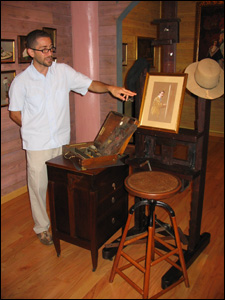
The re-creation of the studio, done up with a loving, meticulous hand by artist Antonio Martorell, will not be everyone’s cup of meat—be forewarned that there is lots of stained and painted lath, an easel with brushes (though a truly impressive piece of furniture built by Frade himself), tiny paintings everywhere and a crammed bookcase. But Frade’s life had great bohemian dash—unfulfilled commissions, curmudgeonly exile, a painting shot at and damaged during a revolutionary siege—and Jonathan’s narration of it, mostly by way of art works, is thorough and vivid. Don’t miss the museum’s rotating display of Puerto Rican posters on the way out.
At left: Jonathan Berrios, self-described “Handyman Cultural,” going all-out during the Frade tour.
You can access Rotund World features and the archives here. To find out how to participate in this swell, very avant, very too-too enterprise, click here. For Rotund Episode #1, Part I, an island soliloquy, click here. Part II features a tribute to the outstanding Ponceño torrefacción, Café Mayor, and our first roundup of Island art exhibitions, including an ill-conceived look at Pedro Vélez’ ill-conceived show, “Godfuck.” Cliquea aquí. Rotund Episode #2 reconsiders Pedro, visits an art show curiosity, and gets a haircut, here. In Episode #3 ÁREA and “The (S) Files” get the Rotund treatment. Here is Booty Bundt, and this takes you back to our newest episode.
 ¿Juvenil o derivada? Not a pertinent question, says Marysol Nieves. And she should know.
¿Juvenil o derivada? Not a pertinent question, says Marysol Nieves. And she should know.
